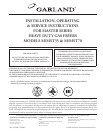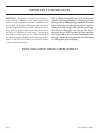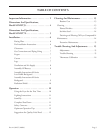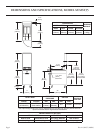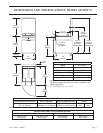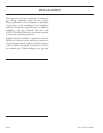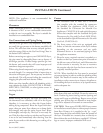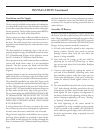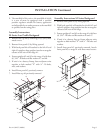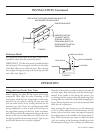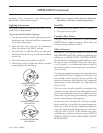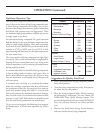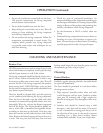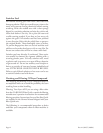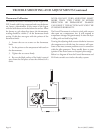
Part # 1382677 (08/06)Page 8
INSTALLATION Continued
Ventilation and Air Supply
One of the most important considerations is ventilation.
e fryer must be installed so that products of combustions
are removed efficiently, but so that the kitchen ventilation
system does not produce drafts that interfere with proper
burner operation. e fryer flue opening must NOT be
placed close to the intake of the exhaust fan.
e fryer must never have its flue extended in a chimney
fashion. is changes the combustion characteristics of
the fryer. is will cause the fryer to be slow to recover,
frequently cause delayed ignition, and sometimes cause
pilot outage.
e ideal method of ventilating a fryer is the use of a
properly designed canopy which should extend six inches
(”) (mm)beyond all sides of the appliance and six
feet (’) six inches (”) (mm) from the floor.
Many operators do not realize that the finest ventilation
system will break down when it is not maintained
properly. e duct system, the hood, and the filter
bank must be cleaned on a regular basis and kept free
of grease.
Adequate distances must be maintained from the flue
outlet of the fryer to the lower edge of the filter bank.
Filters should never be installed in the horizontal position.
ey should be installed at an angle of degrees, and
a drip tray should be located beneath the lowest edge of
the filter. NFPA Standard No. states that “A Minimum
distance of ” (mm) should be maintained between
the flue outlet and the lower edge of the grease filter.”
We recommend that the MINIMUM DISTANCE BE
” (mm) FROM THE FLUE OUTLET TO THE
BOTTOM EDGE OF THE FILTER WHEN THE
APPLIANCE CONSUMES MORE THAN ,
B.T.U. PER HOUR.
A strong exhaust fan will create a vacuum in the room,
for an exhaust system vent to work properly, replacement
air must enter the room in which the vent is located.
All gas burners and pilots need sufficient air to operate
and large objects should not be placed in front of this
fryer which would obstruct the air flow through the
front. A minimum of ” (mm) should be provided at
the front of the unit for servicing and proper operation.
Air for combustion enters the unit below the cabinet
at the base. Do not place anything around the base or
under the fryer.
Assembly Of Battery
All heavy duty batteries equipment is aligned and fitted at
the factory, from left to right and must be installed in this
order. ere is a diagram provided with every heavy duty
battery. All M/MST Fryers and M/MST Fryers may
be installed to battery with other GARLAND Series
Ranges, sharing common manifold connections.
A. All such units should be placed in their respective
battery position. Detach valve panels to prevent
damage, remove them from the area where the
battery is being assembled.
B. Level each unit (if a range, to the oven rack) by
adjusting the six inch (6”/152mm) legs, or where
legs are not used, adjust level with shims. Readjust
legs, if required.
C. Connect units together by mating the unions at
each end of the manifold. (Adjoining units must
have matching unions, unless the union parts are
of the same specifications, a leak proof connection
cannot be assured.) Hand tighten unions at this
point.
D. e units should be fastened at the rear by inserting
5/16” bolts through the holes provided at the rear
of the burner box sides. Install washer and nut and
hand tighten. Be sure of proper unit alignment in
the battery before final tightening of these bolts or
unions. Improper tightening will cause “fanning”
or “bowing” of batteried units.
e final tightening of the union should be
accomplished by using a suitable spanner wrench.
If such a wrench is not available, the GARLAND
union collar has special ridges, and a cold chisel can
be driven against these ridges to properly seat and
seal the union.



